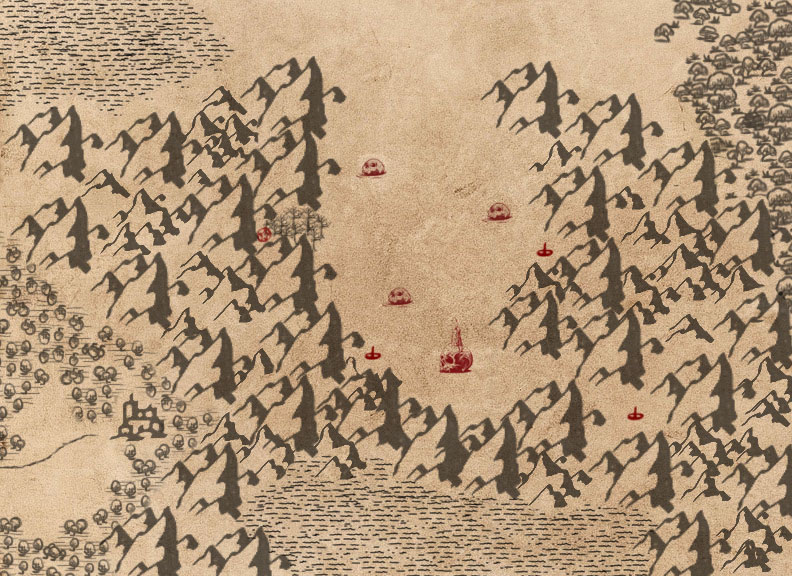History
The Venous Plague is a vicious and highly viral disease that has ripped through the populations of the Western Coast of Fyria numerous times over the past few generations. It is a mysterious plague that only shows itself every few decades, appearing without warning and decimating thousands upon its arrival each time. It is a disease that inflames the skin, and boils the blood, leaving its victims confused and gasping for breath before their organs fail and they slip away into the darkness of the beyond.
The first cases of this disease were reported to have originated in a small fishing village on Heldrin's southern coast near the border of Casarei. This was nearly two hundred years ago and ever few decades since then the disease will flare up and sweep the western coasts, killing thousands before quietly disappearing again. The most recent wave of the Venous Plague occurred less than ten years ago. It hit
Heldrin the worst, as it often does, with nearly a thousand citizens killed in a matter of days.
The plague has been a scourge to the people of western Fyria, many live in fear of when it will return due to the chaotic nature of its often unpredictable arrival. And while a cure for the Venous Plague was recently discovered it has down little to calm the fear that lives within many people's minds; and many researchers both within Heldrin and out believe that their fervour to find a cure may have unintentionally doomed them all.
Symptoms
The Venous Plague is a killer, and its end goal is nothing less than the death of its host. It has a variety of symptoms that lead up to the afflicted's death and does so by invading their bloodstream and attaching tiny bits of itself to as many cells as it can. This utterly destroys the body's ability to absorb oxygen into the bloodstream and causes a chaotic and painful cascade of symptoms in a short amount of time.
The disease is extremely deadly, and while the victim does have to suffer through a variety of symptoms Venous Disease kills even the strongest individual in a few short days. The symptoms of the disease beginning after a short incubation period, usually within 24 to 48 hours of contracting the virus, and it hits with swift brutality. The victim will first begin to experience some discomfort, excessive sweating, and a feeling of anxiety. This is followed by the development of a headache, shortness of breath, and feelings of body fatigue. These symptoms will increase in severity over the next few hours, and usually, by night end the victim will be dealing with an excruciating headache, excessive wheezing and the inability to catch one's breath, and intense body pains and shakes.
By the following morning, the victim will have contracted a high fever and will have become incoherent and unable to move as their limbs have become too weak from lack of oxygen and reduced blood flow. Around this time, their skin will begin to lose its colour and begin turning a dark blue. A morbid indication that the oxygen levels in their blood are dangerously low and entering the zone of no return. At this point in the course of the plague's reign inside its victim, it will be nearly impossible to revive the patient, and it is likely only a matter of time before their demise.
The last phase of the disease is a nightmare to behold, the skin becomes taut and leathery, theirs eyes yellowed and sunken, and the sound of the victim's vain attempts at grasping for air fill the room in which they lie. All occurring in the victims last few hours of life, before their body gives up and their organs fail one by one. Victims of the Venous Plague often die like this, wheezing and coughing in sick gurgles, though one small comfort is that the victim has likely fallen away from consciousness hours before the worst of the disease sets in. Most barely realizing they are dying as the disease slowly lulls them into the eternal slumber of death.
Transmission
Despite Venous Plague's lasting presence on the west coast over the last two centuries, not much is known about how it spreads or why it only appears every couple of decades. The longest Venous Plague has ever stayed dormant was forty years, while the closest gap between outbreaks was a mere five years. This short gap between outbreaks nearly caused the demise of a township in Casarei as nearly half of their noble family was stricken by the disease and perished.
Venous Plague mysteriously seems to stay within the confines of the western coast, targetting Heldrin and Casarei most often. Some cases have been reported over the years in more remote locations like the Jungles of Mijhail and Aldelgis, but the disease never seems to make it far past the borders of these nations, seemingly unable to find purchase in these places.
The prevailing theory is that the virus cannot handle these nations harsher and more extreme climates, with Mijhail experiencing extreme heat much of the year, and Aldelgis, a nation that endures harsh winters for an extended amount of time each year. In contrast, while Casarei and Heldrin experience both winter and summer they only garner much milder temperatures year-round.
Finding a Cure
During the most recent outbreak that struck Heldrin less than a decade ago, researchers in Sumner, the capital of Heldrin discovered that the use of the
Heldra - The Flickering Fire Flower could reduce the effects of Venous Plague if consumed carefully and in small doses. Consumed raw the flower can have negative effects on the consumer's stomach, as the stem of the flower contains a somewhat acidic liquid. Regardless, these initial tests showed signs that the flower did slow the symptoms of Venous Plague.
After extensive experimentation, the Heldrin researchers discovered that the same thick and slightly acidic liquid could be distilled into a powerful tincture that when administered to a sufferer of Venous Disease orally would almost completely stop symptoms within a few hours, saving the life of the patient in the process. However, this tincture only goes so far and if it has any chance of saving the patient's life must be administered before the victim's skin begins turning blue. Despite the careful timing required when administering the cure, it has proved an invaluable tool in the fight against this disease.
Unfortunately, due to the high number of flowers used during this research, and in the subsequent fight to save as many lives as they could during their last outbreak, Heldrin's population of the Heldra has been decimated. As such, the Heldra is now extremely endangered, and due to the difficulty in finding new crops of the flower to assist in population, it is unforeseen when the cure can begin mass production in preparation for the next wave of Venous.
King Thadeus Telvour VIII shortly after the last outbreak, decreed that all citizens must immediately report any new Heldra crop to servants of the crown. If any citizen is caught growing Heldra without reporting their crop, or if they fail to report a newly discovered crop they will be jailed and their families will receive a heavy fine. When crops of Heldra are properly reported experienced botanists, approved by the king's court, are sent to collect samples of the Heldra seeds for future growth and to personally oversee the growth of the potential yield.
While many citizens praise the researchers of Heldrin for their discovery of a cure for the Venous Plague, many more have deemed them reckless and moronic for their frantic and dangerous overuse of the Heldra Flower. Many citizens believe that if an outbreak of Venous Plague was to happen again before the Heldra population can be strengthened that Heldrin and the entire western coast could be faced with utter devastation.






Comments